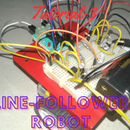Introduction: Paper Capacitor
Hello every one....
Today I would like to share a new project for you.
All are familiar with capacitors. It is an important component in the electronics field. It is in different types ceramic, electrolytic, tantalum, etc... in different values and in different voltage ratings. Mainly it is used for storing charges for short time periods in circuits. It is also used in filter applications. In the absence of a capacitor electronics is impossible. I done several experiments with the capacitor. So I love it. So here I am going to make a simple capacitor from home. The initiative behind the project is to revel the importance and simplicity of capacitors for all of us. Here I made it by using magazine paper. That is the dielectric in the capacitor is magazine paper. So it is known as paper capacitor. This make it become a fully home made one. It is very interesting for electronic beginners and electronic enthusiasts like me. I believed that it is helpful for you. OK.
So, Lets start it......
Step 1: What Is a Capacitor ???
Basically capacitor is a passive component which store charges in it. The stored energy is in the form of electric energy in the electric field between the plates. This make the difference between the capacitor and a battery. Battery stores energy in the form of chemical energy but capacitor store directly. The capacitor is a two leg component. The two legs are connected to the two parallel plates and an insulating material called dielectric placed in between them. Normally capacitor connected in parallel with circuits. When connect in parallel to the battery it charge up. The plates charged in opposite polarity. So the charge is hold in it due to the electric force between them. This is the basic principle of capacitor.
Uses
- Store charges
- Ripple filtering
- Signal filtering
- In resonance circuits
- Surge protections
- Impedance matching
- Coupling
etc..
For more details about capacitors, visit my blog, link given below,
https://0creativeengineering0.blogspot.com/2019/03/home-made-capacitors-diy-paper.html
Step 2: Types of Capacitor
The capacitor available in different types. Each types have its own unique properties. The types are given below.
1. Electrolytic capacitor
It is commonly present in high capacitance value ranging from few micro-farads to 10000 micro-farads. It have polarity. The reverse polarity cause damage to it. The dielectric used here is an electrolyte, So it is known as electrolytic capacitor. Commonly it is used to store charges in capacitor. Thus it is used as filter capacitors in rectifiers. The images show in above.
2. Ceramic capacitors
It is made up of ceramic material as dielectric. Commonly it is available in small values ranging from pico-farads to nano-farads range. It have no polarity. Commonly it is rated for high voltages. Commonly it is used for filter application and in RF circuits. It is available in small sizes and also preset in SMD packages. The images show above.
3. Tantalum capacitor
These are high precision capacitors. It have polarity. It is marked on the surface. It is available in wide ranges. It is used for filtering purposes. The images show above.
4. Film capacitor
It is a commonly used type. It is available in nano-farad ranges. It is good for filter applications in audio circuits. Commonly it is rated for high voltages. The images shown in above.
5. paper capacitor
Here the dielectric in between the plates is paper. Use aluminium sheets and paper sheets for constructing it. The alternate paper and aluminium sheets form a stack and it produce more capacitance than a single sheet. It available in small values. It is used for filters. The images show above.
Also there is available numerous type of capacitors. I explain only the frequently used capacitors.
For more details about capacitors, visit my blog, link given below,
https://0creativeengineering0.blogspot.com/2019/03/home-made-capacitors-diy-paper.html
Step 3: Our Plan
Here I explain the plan for construction of paper capacitor. The plan is given in the above figure. First we take a magazine paper and then glue the aluminium foil to its both sides. Then attach wires from each sides. Then cover each sides with another two magazine paper for insulation purpose. Then roll it into a round shape to increase the capacitance by increasing the overlapping area. This is our plan. The procedure is given in following steps. OK.
Step 4: Materials & Tools
The above images shows the materials and tools which is used this project. The list is given below,
Materials
Good quality magazine
Conductor wire pieces
Aluminium foil
Glue (fevicol)
Sticky plastic tape
Tools
Paper cutter
Scissor
Wire stripper
Metal ruler
Step 5: Dielectric Making
Dielectric is the element present between the capacitor plates. It has an important role in the value of capacitor. Here I use the magazine paper as capacitor dielectric. In this step I explain how prepare the dielectric. Here I use a good quality magazine papers. It has a small layer of plastic coating. This type paper is good for the dielectric of capacitor.
- Take good magazine and tear its papers using hand
- Cutting its edges of the paper to make a perfect rectangle shape
- Ensure that all has same size
Step 6: Capacitor Plate Making
In the capacitor the charges are stored in the capacitor plates. It is electrically isolated from each other by using the dielectric. The capacitor plate is made by using the aluminium foil. It is conducting material and flexible. The foil is glued into the dielectric paper by using glue.
- Take aluminium foil
- Cut aluminium foil in rectangle shape suitable for the dielectric paper but keep the rectangle size is little bit less than the paper
- Cut two aluminium pieces
- Apply fevicol glue to the paper
- Distribute the fevicol in a uniform manner to the whole paper
- Stick the aluminium foil to the paper keeping at center
- Repeat this procedure for second side of the paper
Now we completed the capacitor main part making.
Note: Ensure that the aluminum foil size is smaller than the paper and t is placed at the center other wise there is a chance for short between the two plates.
Step 7: Connecting the Capacitor Leads
Here we connect the wires to the capacitor plates for connecting it to the outside world. The two leads of the capacitor coming from the two aluminium foil plates. This is connected to the conductor wire by using plastic stick tapes.
- Take two wire pieces and strip its end insulation
- Spread the copper strands
- Fix it to the aluminium foil using sticky plastic tape
- Take the second wire from the opposite corner of the opposite side
Step 8: Insulating the Plates
Now we completed the basic capacitor creation. Now we going to cover the bare aluminium foil. Otherwise it make short-circuit when it is rolling in to cylindrical shape.
- Take two magazine paper
- Apply glue to its one side
- Spread it uniformly throughout the paper
- Stick it to the aluminium foil
- Follow same procedure for second side
- Wait for drying it
Step 9: Increasing the Capacitance
Our capacitor is finished in the previous step. But its capacitance value is very low. So in this step we going to increase the capacitance of our capacitor. To increase the capacitance we roll up the capacitor in to a cylindrical structure. In this shape the capacitor plates make multiple overlapping, so the capacitance area increase thus increases the capacitance.
- Roll up the capacitor tightly from one side
- After completing the roll up apply some tape to fix it in the position
Check for any short by using multi-meter continuity testing feature.
Step 10: Covering for Capacitor
Here I made some art work for capacitor. For this I use some colored plastic stickers which is commonly used in vehicle industry. It is seen in the above mages. You use your custom designs.
Step 11: In Different Sizes
I made not a single one. I made it in different sizes. These are given in the above images. Only the size is different, the making process is in same manner as seen before. The capacitor testing is given in this video. Please watch it.
You make your own capacitors.
It makes you as a science enthusiast.
Thank you...






